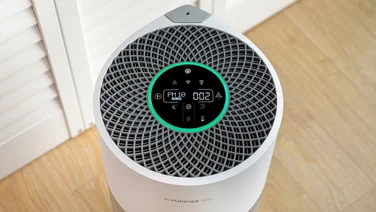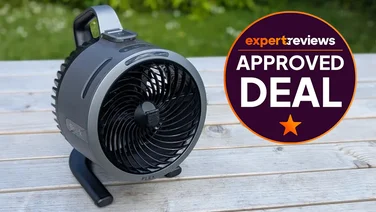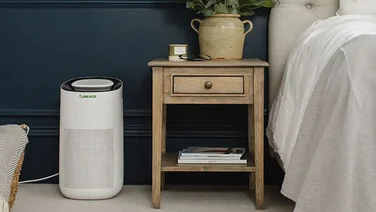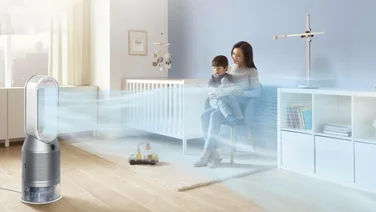To help us provide you with free impartial advice, we may earn a commission if you buy through links on our site. Learn more

Energy costs matter, especially at this time of rising bills and carbon consciousness. The great news is that a dehumidifier can save you money. For instance, if you’re fighting damp and mould in your home, the cost of running a dehumidifier is well worth it if it means avoiding potentially hefty bills further down the line. A dehumidifier is also much cheaper to run than a tumble drier, making it a more affordable way to dry laundry too.
But how much does a dehumidifier cost to run? We’ll be looking to answer that question in this article, focusing on one of the most common types: the compressor dehumidifier.
How much does a dehumidifier cost to run?
We’re doing our maths based on the UK energy price cap at the time of writing, which is 24.86p per kWh. Let’s consider the MeacoDry Arete Two, which we gave a five-star review and a Best Buy award. According to our tests, the Arete Two uses around 220W during normal operation. That works out at around 5.5p per kWh. These figures are for illustrative purposes, but the point is that dehumidifiers are far from expensive to run.
Is it cheaper to run a dehumidifier or a tumble dryer?
The Energy Saving Trust doesn’t have any specific figures for dehumidifiers, but it has done an analysis of tumble dryer energy costs. It says that the average tumble dryer costs £140.24 per year in typical usage. That’s based on a non-vented appliance with a B energy rating (the most common available to buy when the Energy Saving Trust last researched this) and assumes 160 drying cycles of standard cotton programme per year, following EU energy label calculation methodology. Actual energy consumption will depend on the appliance, the programme and how often you use it.
To put this into perspective, 160 “drying cycles” over the course of a year with the 20l Meaco Arete Two mentioned above could cost £35 (based on 160 four hour sessions).
Admittedly, drying clothes with a dehumidifier is a bit more work – you’ll need to hang them out on a rack or hangers – but it’s also kinder to your clothes. You avoid the gradual wear that comes with the agitation of tumble drying, as well as any potential heat damage. And of course, not all clothes can be tumble dried anyway.
What can affect how much a dehumidifier costs to run?
Wattage
To state the obvious, the wattage of your dehumidifier dictates to an extent how much electricity it uses. That doesn’t necessarily mean smaller machines are better – they might be slower or less efficient – but look for one with a mode that stops working once humidity gets down to the right level, so you don’t waste energy.
Windows
As Aneesa Khan, assistant home electricals buyer at VonHaus, says: “Leaving windows open will affect electricity usage as the dehumidifier will need to work harder to remove the excess moisture from the air which has come in from outside.”
Size of room and humidity
A high humidity and a low target means the dehumidifier will work for longer, potentially costing more money. Meanwhile it will take more power to tackle the humidity in large rooms than in small rooms, as there’s more moisture to extract.
Temperature
“A compressor dehumidifier works best in rooms above 15°C,” says Chris Michael, managing director of Meaco. “If used in an unheated room at low temperatures it’s less effective, as it may have to switch to defrost mode to prevent the cold coils, which condense the moisture, from freezing.”
How can I reduce my dehumidifier’s running costs?
Placement
Position your dehumidifier in the middle of the room. “Central placement with good airflow maximises efficiency,” explains Joshua Warren, air treatment expert at electrical retailer AO. There’s more on placement in our article on where to put a dehumidifier.
Keep it clean
As with many appliances, looking after your dehumidifier and keeping it in a good condition will help you a great deal in the long run. “It’s important to ensure the filter is cleaned regularly, as this will allow the dehumidifier to run more effectively,” says Aneesa Khan.
Stay small
“Placing the dehumidifier in a smaller room will reduce the electricity usage. It shouldn’t take as long to remove the excess moisture from the air compared to a larger room,” adds Khan. So, unless you’re trying to reduce the humidity in the whole house, go for a small room and close the doors.
Close your windows
Close the windows, too. “A dehumidifier works by removing moisture from the air,” explains Joshua Warren. “If you leave windows open, especially during humid weather, the dehumidifier will have to work much harder, as it will be trying to remove the moisture that continually enters from outside. This reduces its efficiency and leads to higher energy consumption.”
Leave it on!
“It sounds strange, but you can save on running costs by leaving the dehumidifier on 24/7,” says Chris Michael, managing director of Meaco. “This way, the dehumidifier is able to maintain an optimum humidity level without having to work harder once the dehumidifier has been switched off for a period of time and the humidity has increased.”





